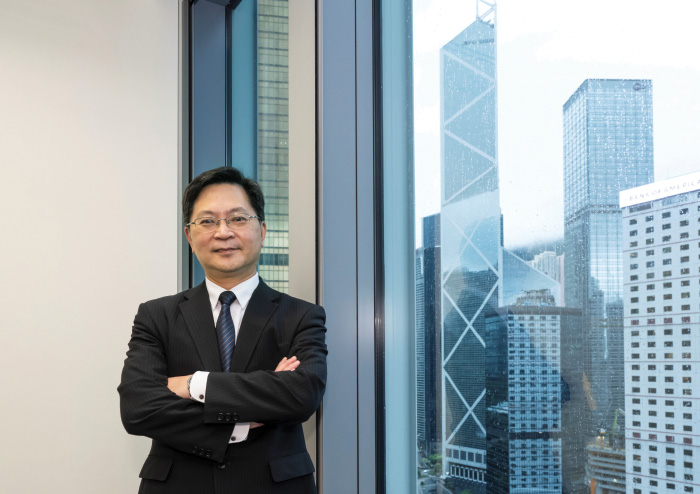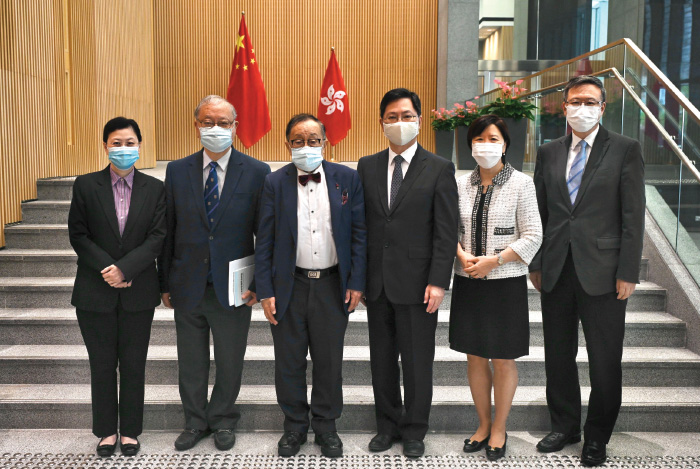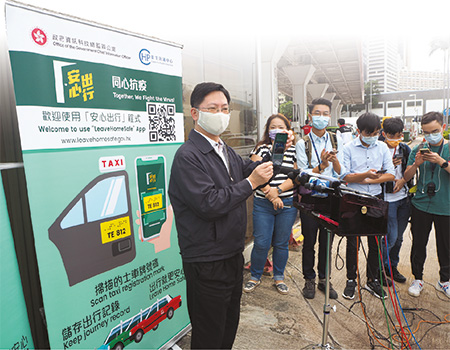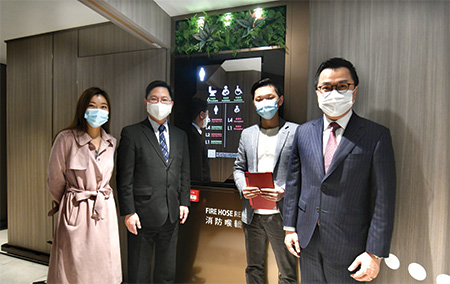


Civil Service Newsletter Editorial Board


After completing an Associateship in Electrical Engineering at the then Hong Kong Polytechnic (later renamed as the Hong Kong Polytechnic University), Mr Sit was up against stiff competition when he decided to join the Civil Service. He recalled, “There were multiple paths I could have taken after graduation, but I was drawn to a career that would enable me to serve the public, so I decided to join the Government in 1982. At that time, I competed with hundreds of Electrical and Mechanical Engineering graduates for only a handful of vacancies in the Electrical and Mechanical Services Department (EMSD). I was fortunate to get an offer for a two-year Engineering Graduate Training Scheme, after which I became an Assistant Mechanical and Electrical Engineer.”
In the early 1990s, before the Daya Bay Nuclear Power Plant in Shenzhen was brought online, Mr Sit was sent on an international assignment to learn first-hand information about nuclear plant operation. He said, “At that time, the Government was assessing the potential risks associated with nuclear plant operation, but there were no experts on nuclear plant safety in the civil service. So, a colleague and I were sent to the Koeberg Nuclear Power Station just north of Cape Town in South Africa for around eight months to learn more about nuclear plant operations and relevant contingency plans.” Shouldered with the big responsibility, this critical mission further impressed upon him the impact of his work and his calling to serve the community. He added, “From that moment, I also realised the significance of looking at new technologies objectively with an open mind and carefully evaluating their strengths and weaknesses for effective use.”
With the enactment of the Trading Funds Ordinance, trading funds were first introduced in Hong Kong in 1993. The trading fund provides a financial and accounting framework that empowers a government department to adopt accounting and management practices commonly used in the private sector. EMSD, where Mr Sit was working at the time, was one of the government departments selected for migration to a trading fund operation. He noted, “While remaining as a public entity, EMSD could operate on a self-financing model under the trading fund, with its revenue coming from the fees it charged for its services. This change in government policy inspired me deeply, as market competition drove us to become even more citizen-centric and take a client-oriented approach.” He added, “Our purpose became much more distinct, as only by fully understanding the needs of our ultimate clients — the public — and providing services that they need could we prove our real market value.”
Hong Kong’s economy started to take off in 1970s and many major infrastructure and buildings were constructed and put into service since then. Unlike the civil and structural elements of these major facilities which can last for more than 100 years with proper design and maintenance, the normal lifespan of most of the electrical and mechanical engineering systems in these facilities like lifts and escalators is much shorter. Proper maintenance is essential to ensure their safe operation and EMSD is responsible for the enforcement of relevant legislation to control the maintenance standards. Hong Kong has been facing the challenges arising from ageing electrical and mechanical assets. These challenges were intensified when the available workforce in the engineering industry is shrinking due to various reasons e.g. ageing population. The community has to find ways to address the double ageing challenges (i.e. ageing assets and ageing population) and the application of innovative technology is certainly one of the solutions.
Mr Sit added, “It is also a challenge for engineering talent to keep up with the times in this rapidly evolving sector. The use of innovative technology greatly helps increase efficiency. Now, we can deploy drones to inspect and record the status of external pipes, lighting and other facilities on high-rise buildings. Working closely with technology empowers us and extends our capabilities to serve the public and help resolve the manpower shortage problem in the industry.”
When Mr Sit was appointed as the Secretary for Innovation and Technology in 2020, this was right at the height of the Coronavirus Disease 2019 (COVID-19) epidemic. At that time, public demand for anti-epidemic masks was rapidly outstripping supply, and the Innovation and Technology Bureau (ITB) was tasked to help address this critical challenge. Mr Sit recalled, “After obtaining the funding approval, ITB worked with the Hong Kong Research Institute of Textiles and Apparel for the rapid development of the reusable copper core anti-epidemic masks (the CuMask+™) for distribution to all Hong Kong citizens for free. This is a great example of the Government making full use of its own institutional network, successfully leveraging local research and development facilities to work towards a common goal and help citizens fight the epidemic.”
In response to the rapid changes of the epidemic, the Government has also introduced various applications of information technology (IT) to help support the home quarantine measures, such as the evolvement from the original reusable electronic wristband to the disposable electronic wristband, paired with the “StayHomeSafe” mobile application. The latest model can detect and analyse environmental communication signals at the confinees’ dwelling places by using geo-fencing technology (including Bluetooth, Wi-Fi and geospatial signals in the neighbourhood). Mr Sit said, “This use of geo-fencing technology to determine whether a person under home quarantine has left his / her place of residence is a further example of how the Government is continuously learning and improving its services while leveraging a variety of technological solutions to bring a multi-pronged approach to help fight the epidemic.”
Another project launched by ITB in May 2020 was the Distance Business (D-Biz) Programme which aimed to support local businesses to continue their services during the epidemic. Instead of offering direct subsidies to support the business, the Programme provided funding to enable the enterprises to adopt IT solutions for remote working and distance business during the epidemic.
Mr Sit said, “The D-Biz Programme in particular helps the small and medium-sized enterprises (SMEs) in improving their online business, digital payment systems, cybersecurity, as well as online/cloud financial and human resources management systems, etc. As you can imagine, it is not easy for enterprises to embark on the path of digital transformation, especially when they are shouldering unprecedented business pressures and challenges during the epidemic. But the SMEs know that if they do not change, they cannot sustain the development.”
Through fast-track processing under the Anti-epidemic Fund of the Government, ITB was able to fund each enterprise up to HK$300,000 for up to three key IT solutions. The Programme received an overwhelming response from the enterprises and the funding was increased from the initial HK$500 million to $1.9 billion. In total, over 38,500 applications from about 32,000 companies were received, of which almost 95% came from the SMEs.
In December 2017, the Government announced the Smart City Blueprint for Hong Kong (the Blueprint), which set out 76 initiatives under six smart areas: Smart Mobility, Smart Life, Smart Environment, Smart Citizens, Smart Government and Smart Economy. Many such initiatives have already been successfully launched, including digital infrastructure projects, the Faster Payment System (FPS), and more free public Wi-Fi hotspots.
Building on this success, the Blueprint 2.0 will further usher over 130 initiatives to enhance existing city management services and bring greater convenience to the public. Through such smart city initiatives, everyone can benefit from I&T in their daily lives. Mr Sit added, “One example is the ‘iAM Smart App’ which provides a one-stop personalised digital services platform facilitating electronic authentications, online form filling and digital signing.”
Mr Sit remarked, “Indeed, our vision goes far beyond Hong Kong. We aim to build smart city clusters and connect with other cities in the Greater Bay Area.” He added, “The road to this smart city construction is like a running race and every second counts. Our vision is to embrace I&T to build a world-renowned Smart Hong Kong with a strong economy and high quality of living.”
From his over thirty years of service in the Government, Mr Sit sees himself as “a servant of all servants”. He explained, “As one of the major duties of ITB is to provide support to all other government bureaux and departments to make good use of innovative technologies to serve the community at large and the public have high expectation of the Government, we have to understand the operations of the market and optimise our services to ensure they meet public expectations.”

Mr Sit cited an example from his time in EMSD, “I often shared with my colleagues that if they wished to strive for excellence so as to get ‘Outstanding’ gradings in their appraisals, they need to take bold action and dare to challenge the ‘usual’ practice. Just to follow and work as per the ‘normal’ standard would not suffice. They would need to go the extra mile and do something that could make a difference to help bring about improvement of service and be beneficial to the development of the department. Only by such breakthrough could civil service performance consistently exceed expectations and provide the best service in serving the public.”

Mr Sit recalled an unforgettable scene during the outbreak of the severe acute respiratory syndrome (SARS) in 2003. He was working in EMSD and responsible for providing electrical and mechanical support to public hospitals for converting the normal wards into negative pressure rooms. When he met the medical team of the Princess Margaret Hospital which was designated as the SARS hospital for receiving all SARS patients, the entire team stood fast at their posts and dedicated themselves to taking care of the patients under extremely stressful and often risky conditions. Mr Sit said, “Their dedications in serving the community were remarkable. Similarly, we should never forget why we choose to join the service and continue to forge ahead to give our best for the society.”
Despite his busy work schedule, Mr Sit still makes time to help the community through voluntary work in different non-government organisations like the Heep Hong Society which he has been serving for many years. The volunteer work allows him to meet the grassroot families and understand their needs. He concluded, “Everyone has his / her own areas of expertise and we can all help make Hong Kong an even better place to live.”